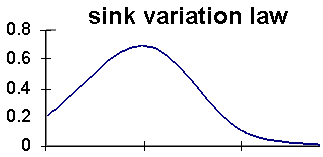Preliminary Course.
Eco-Physiology
Biomass partitioning.
Biomass partitioning, Sinks
-
Biomass partitioning or allocation is the distribution of growth over the different organs
(roots, leaves, stems, fruits, rings).
Biomass partitioning among the organ cohorts is not constant and results from competition.
Organs are in competition for assimilates (or biomass) during their growth.
For a given organ, the ability to accumulate biomass is characterized by its sink strength, expressed by a dynamic value for a given duration, i.e. the organ expansion time.
The set of sink values during organ expansion defines the organ sink function, φo.
On a given date t, organ size results from biomass accumulation.
Each biomass increase q(t) is defined from the total available biomass Q(t), and the relative ratio of the organ sink φo / Σjφj, with j respectively standing for all the different organ types (all roots, all leaves, etc.).
-
q(t) = Q(t) . φo / Σjφj
Sink function definition.
The sink function value has to be expressed according to organ expansion, i.e. its age.

A typical sink function (leaf), defined on an expansion period of duration 3.
(Graph: P. de Reffye, CIRAD)
Sources
-
Sources
-
Organs producing biomass (usually restricted to functioning leaves) are called source organs.
The ability of the source to produce biomass also depends on time; it increases with organ growth before reaching a stable value.
The source function is therefore expressed in terms of a functioning duration, usually longer than the organ expansion duration.
Source function definition.
-
The source function values are defined as a function of the organ age.
Beta laws can be used to express these functions, giving a wide range of shapes from two single parameters,
from appearance time to final expansion. At this final stage, the source value is based on the remaining functioning duration.
